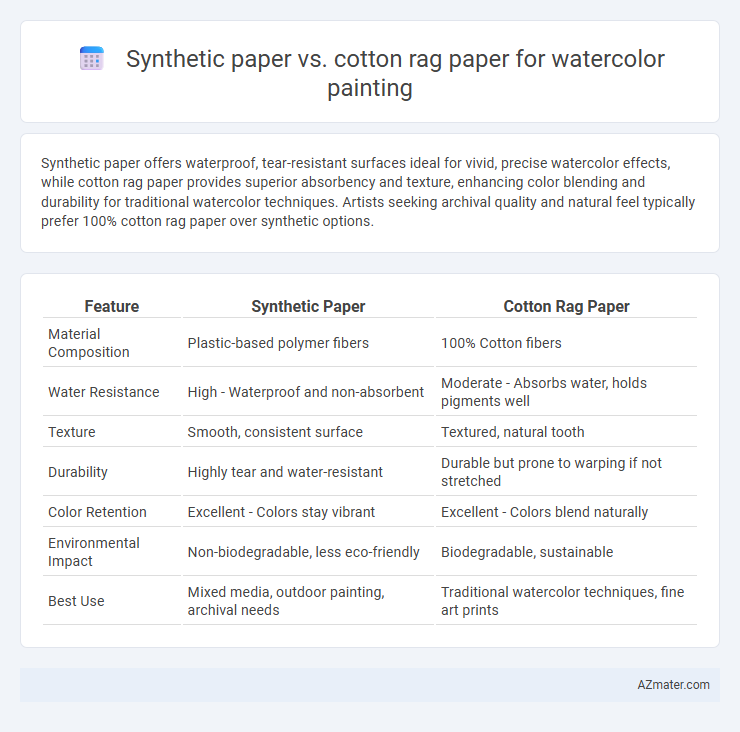Synthetic paper offers waterproof, tear-resistant surfaces ideal for vivid, precise watercolor effects, while cotton rag paper provides superior absorbency and texture, enhancing color blending and durability for traditional watercolor techniques. Artists seeking archival quality and natural feel typically prefer 100% cotton rag paper over synthetic options.
Table of Comparison
| Feature | Synthetic Paper | Cotton Rag Paper |
|---|---|---|
| Material Composition | Plastic-based polymer fibers | 100% Cotton fibers |
| Water Resistance | High - Waterproof and non-absorbent | Moderate - Absorbs water, holds pigments well |
| Texture | Smooth, consistent surface | Textured, natural tooth |
| Durability | Highly tear and water-resistant | Durable but prone to warping if not stretched |
| Color Retention | Excellent - Colors stay vibrant | Excellent - Colors blend naturally |
| Environmental Impact | Non-biodegradable, less eco-friendly | Biodegradable, sustainable |
| Best Use | Mixed media, outdoor painting, archival needs | Traditional watercolor techniques, fine art prints |
Introduction to Watercolor Paper Types
Watercolor paper types significantly impact painting outcomes, with synthetic paper offering smooth texture, durability, and resistance to warping, ideal for beginners and experimental techniques. Cotton rag paper, composed of 100% cotton fibers, provides superior absorbency, texture, and archival quality favored by professional artists for vibrant washes and longevity. Understanding these differences helps artists choose the best watercolor paper based on their style, technique, and desired finish.
What is Synthetic Watercolor Paper?
Synthetic watercolor paper is a non-absorbent, smooth surface made from plastic materials such as polypropylene, offering durability and resistance to warping compared to traditional fibers. It does not absorb water or pigment like cotton rag paper, allowing for vibrant color retention and easy lifting or blending without paper damage. While cotton rag paper provides natural texture and absorbency ideal for washes and granulation, synthetic paper excels in precision techniques and repeated reworking.
Defining Cotton Rag Watercolor Paper
Cotton rag watercolor paper is made from 100% cotton fibers, offering superior absorbency and durability that enhances the vibrancy and texture of watercolor pigments. Unlike synthetic paper, which is typically plastic-based and non-absorbent, cotton rag paper allows for better water retention and layering, resulting in richer color depth and smoother washes. This archival-quality paper is preferred by professional artists for its ability to withstand multiple washes and erasures without warping or degrading.
Surface Texture and Absorbency Comparison
Synthetic paper for watercolor painting offers a smooth, non-porous surface that allows colors to sit on top, providing vibrant, sharp details without excessive bleeding. Cotton rag paper, made from 100% natural fibers, features a textured surface with high absorbency, enabling better water retention and gradual pigment blending, crucial for traditional watercolor techniques. The choice between synthetic and cotton rag paper hinges on desired texture effects and control over water absorption, with synthetic favoring crisp lines and cotton rag suited for rich color diffusion.
Durability and Longevity of Each Paper
Synthetic paper offers exceptional durability and resistance to tearing, water, and chemicals, making it ideal for watercolor artists seeking long-lasting artwork that withstands handling and environmental factors. Cotton rag paper, composed of 100% cotton fibers, provides superior archival quality with natural aging resistance and acid-free properties, ensuring the longevity of watercolor paintings over centuries without yellowing or deterioration. While synthetic paper excels in physical strength and waterproof durability, cotton rag paper remains the preferred choice for traditionalists valuing proven archival performance and longevity in fine art watercolor.
Color Vibrancy and Paint Lifting Ability
Synthetic paper offers superior paint lifting ability due to its non-porous surface, allowing artists to easily correct mistakes and achieve vibrant color layers without absorption. Cotton rag paper excels in color vibrancy by absorbing watercolor pigments deeply, resulting in rich, luminous hues and a textured finish that enhances the artistry. Selecting between synthetic and cotton rag paper depends on the desired balance between ease of lifting paint and achieving intense, vibrant colors in watercolor painting.
Suitability for Various Watercolor Techniques
Synthetic paper offers a non-absorbent, smooth surface ideal for detailed washes, glazing, and mixed media due to its durability and resistance to warping. Cotton rag paper provides superior water absorption and texture, making it well-suited for wet-on-wet techniques, lifting, and blending, which enhance vibrant color transitions and depth. Artists often choose synthetic paper for precise control and longevity, while cotton rag paper is favored for its traditional feel and ability to handle heavy water applications.
Environmental Impact and Sustainability
Synthetic paper for watercolor painting, made from plastic polymers, often results in higher environmental impact due to non-biodegradable waste and energy-intensive production processes. Cotton rag paper, crafted from 100% cotton fibers, offers superior sustainability with its renewable materials and biodegradability, supporting eco-friendly art practices. Artists prioritizing environmental responsibility typically prefer cotton rag paper for its minimal carbon footprint and recyclability.
Cost and Accessibility Factors
Synthetic paper for watercolor painting offers greater affordability and widespread availability compared to cotton rag paper, making it a cost-effective choice for beginners and hobbyists. Cotton rag paper, composed of 100% cotton fibers, is significantly more expensive due to its durability, archival quality, and superior texture favored by professional artists. While synthetic paper is accessible in most art supply stores and online retailers, cotton rag paper may require purchase from specialized suppliers, impacting both cost and ease of acquisition.
Choosing the Right Paper for Your Art Style
Synthetic paper offers a smooth, non-absorbent surface ideal for artists seeking vibrant, sharp details and durability with watercolor techniques that require multiple washes without warping. Cotton rag paper excels in texture and absorbency, providing superior color blending, richness, and archival quality favored by traditional watercolorists aiming for expressive, layered effects. Selecting the right paper depends on your desired technique--synthetic for precision and ease of use, cotton rag for depth and classic watercolor aesthetics.

Infographic: Synthetic paper vs Cotton rag paper for Watercolor painting
 azmater.com
azmater.com